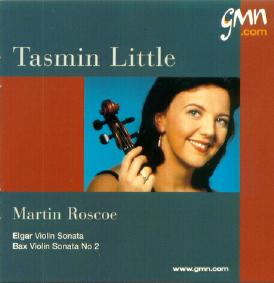Bax’s Second Violin Sonata coupled with the Elgar Violin Sonata on GMN
Elgar: Sonata for Violin and Piano. Bax: Sonata No. 2 for Violin and
Piano. Tasmin Little (violin), Martin Roscoe (piano). Global Music
Network CD: GMNC 0113.
THE SIR ARNOLD BAX WEB SITE
Last Modified July 25, 2000
VISIT GMN’s WEB SITE FOR DETAILS ON ORDERING THIS DISC:
www.gmn.com
Review by Graham Parlett
It is encouraging to see the proliferation in recordings of Bax’s chamber music over the last few years. There are now splendid CDs of most of the larger pieces on Chandos and Hyperion, and Naxos have started their own series, with a recording of harp works released in July and the string quartets from the Maggini Quartet in the pipeline. It is especially good to find that performers are now turning their attention to the violin sonatas, which have been particularly neglected: this new recording from GMN of No. 2 is only the third recording of the work ever to have been released. The earliest, played by Henry Holst and Frank Merrick, came out in 1966 on a limited edition mono LP from the Frank Merrick Society and has never been reissued. Another twenty-four years elapsed before Chandos issued the first CD version with Erich Gruenberg and John McCabe. Both these performances, however, must now yield to this splendid new release.
The Second Sonata was completed originally in 1915 but never performed, and eight years later Bax published it in a revised version. Most of Bax’s extended works are in three movements, but this sonata is in four connected movements. The idea of linking movements is paralleled in a few other works, such as the Phantasy for viola and orchestra, the Fantasy Sonata, and the Symphonic Phantasy (later renamed Sinfonietta). It is clear that the word ‘Fantasy’ (the title of the Second Sonata’s first movement) was associated in Bax’s mind with the use of cyclic structures and motto themes, and he used the device as a means of lending unity to works in which the sonata-form principles which he generally favoured are more loosely applied than usual.
As Tasmin Little points out in her informative and enthusiastic notes, the motto theme that occurs throughout this work is also to be found in Bax’s tone-poem November Woods. After the grim opening page (‘Slow and gloomy’), in which much of the thematic material is adumbrated, the performers launch confidently into the main Allegro (‘rough and fierce’), which is taken at just the right speed, with plenty of forward momentum but not too rushed. A calmer rising figure first heard on the piano (‘singing boldly’ is Bax’s helpful marking), provides contrast before a brief recapitulation dies away and leads into the second movement, entitled ‘The Grey Dancer in the Twilight’. This is a fast waltz full of fantastic and imaginative touches. Bax suggested in his original programme note that it might have been called ‘The Dance of Death’, and there are several allusions to the Dies Irae. Again, the performers play with consummate skill and make the most of the contrast between the carefree associations of the waltz form in which the movement is set and the actual musical content, with its clear allusions to the appalling tragedy of the Great War.
The slow third movement, with its occasional echoes of Debussy, is the emotional heart of the work, and here the performers play with great delicacy and, where appropriate, passion, again making the most of the extreme contrasts in mood that are indicated throughout by Bax’s frequent markings (‘very still and subdued’, ‘wistful and languid’, ‘singing clearly’, etc.). fourth movement is an Allegro feroce, with many changes in time signature including the rare 11/8 – the only work I can think of in which Bax uses it. The ferocity culminates in a passage very high up on the violin marked ‘desperately’, and the work ends with a tranquil epilogue in which the main thematic material is heard again but now with all passion spent.
Tasmin Little and Martin Roscoe have performed this work many times in concert, and this shows in the confidence of their playing and their assimilation of Bax’s musical style. (Mr Roscoe has also played Bax’s music as a soloist, having given the first performances of In the Night and the original piano version of Nympholept.) This is a work that shows Bax in expansive and wayward mood, and in lesser hands it can sound indulgent, but here the performers are highly successful in holding the work together, and the listener’s attention is maintained throughout.
The Elgar Sonata, of course, is much better known and has received far more recordings over the years, from Albert Sammons to Nigel Kennedy. But having made comparison with some of the other recommended performances in the catalogue, I can certainly confirm that this new one stands among the very finest and can be warmly recommended to all Elgarians.
The quality of Mike Hatch’s recording, made in the Old Market, Hove, is superb: a really warm and natural sound, and it would be difficult to imagine a better balance between the two instruments. I certainly hope that these fine artists (and GMN) will now turn their attention to Bax’s other sonatas. Meanwhile, I am sure that this CD will receive the success it deserves.
© Graham Parlett 2000

